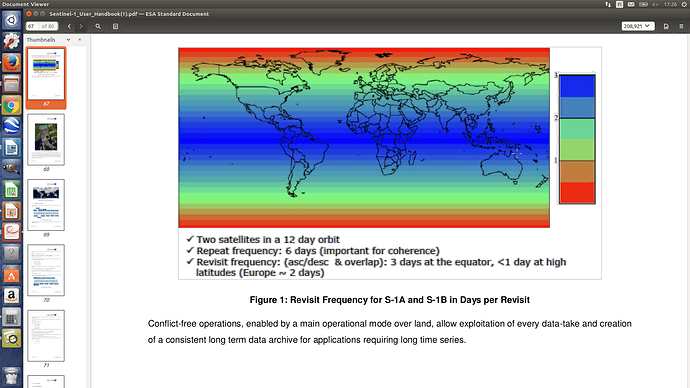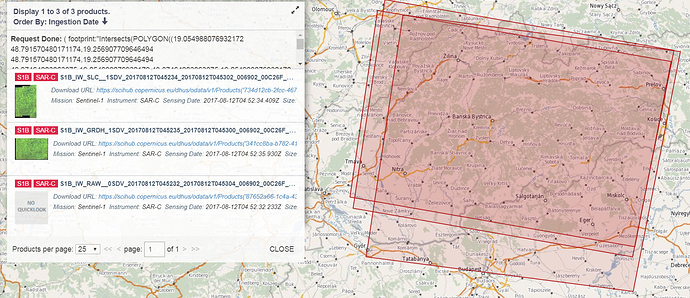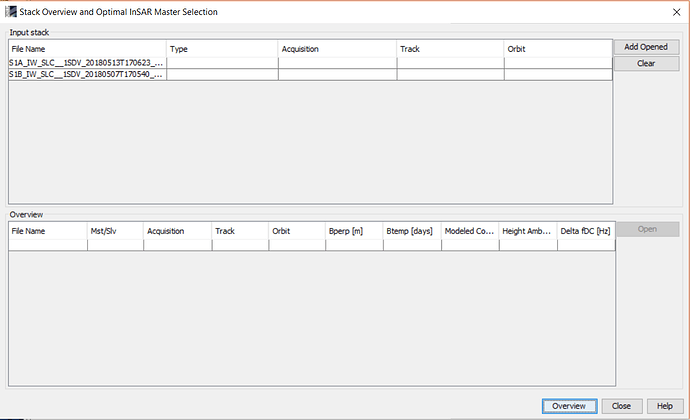Dear all
I want to get a pair for Hailuoto island, Finland (High latitude). As I know and you can see in below picture, as I am working on high latitude, I must get a pair by 1 or 2 days temporal baseline (We want to get as short of a temporal baseline as possible)
but I do not know why I can not find this temporal baseline and the best is 12 days temporal baseline.
consider these two as different:
- revisit time: The time a satellite is able to acquire an image over a certain area. This can be of different tracks (flight paths), different looking directions or different viewing angles.
- repeat frequency: this is defined as the time a sensor needs to cover an area at the exact same track. If you want to do interferometry you need a pair of these.
Interferograms result from stereo images while their perpendicular baseline is exactly known. This baseline however should be considerably short (< 500 m). If you have images from differenent tracks the perpendicular baseline is probably several kilometers. You could still stack them by co-registering but the signal is surely off-phase, meaning that interferometry is no longer possible.
Sentinel-1A hat a repeat cycle of 12 days. Now that Sentinel-1B is in orbit, it can be shortened to 6 days. This his however the smallest temporal baseline possible within the same track.
I do not want to create new topic for a small question related to this topic. You have said and I have read it also elsewhere there is 6 day revisit time of two satellites for the same orbit. But could it be some images are missing ? I have selected small area in Slovakia from this october and there is 6 days difference then S1A is missing so there is 12 days difference and again another 6 days followed by missing S1A with 12 days difference. Some S1A images are missing and more than one time the difference is 12 days.
Also if someone could tell me, why SLC and GRD image of the same date do not exactly much when I see them in scihub map. These are GRD, SLC and RAW products of the same date.
S1 acquisitions are not made strictly regular. There is an acquisition plan but due to various reasons there can be inconsistencies. So I don’t think the image is missing in the archive, it simply wasn’t acquired.
https://sentinel.esa.int/web/sentinel/missions/sentinel-1/observation-scenario/acquisition-segments
https://sentinel.esa.int/web/sentinel/missions/sentinel-1/observation-scenario
Hello,
I need to generate a coherence image and a DEM from the Sentinel-1 data for crop monitoring.
I have downloaded 2 SLC images:
S1A_IW_SLC__1SDV_20180513T170623_20180513T170650_021889_025CF5_5445
S1B_IW_SLC__1SDV_20180507T170540_20180507T170607_010818_013C70_7EDE
First of all please correct me if they form a correct pair for carrying out interferometric processing.
The track, mode and the pass for both of these images are same. However, I go to InStack Overview, I am unable to see any information about the images (as can be seen in the screenshot below).
Please comment.
Thanks,
Sugandh
Hi.
Your images seems to be compatible for InSAR
On the upper part of the screenshot. The columns are also empty for me.
However, when I click on “Overview”, the lower part gets filled. Did you actually clicked on this button?
Yes I did click Overview button. The screenshot I sent if after I click on that button.
Did you import the unzipped data?
@ABraun, Can use advice me how long the temporal baseline threshold should be for sentinel1A data in deformation application?
The temporal baseline that works best for InSAR deformation measurements depends on the environment of the area. If you are trying to use InSAR in an area of significant vegetation, then you will need to use short temporal baselines to get coherent interferograms. The length of time you need to do the InSAR measurements also depends on the rate of deformation you are trying to measure. For slow deformation (less than 1 cm/year), you need to use several years of InSAR measurements. Unless you are working in a desert or very densely urbanized area that stays coherent over long time intervals, you will have to make multiple short temporal baseline interferograms and do either stacking or complete time-series analysis.


